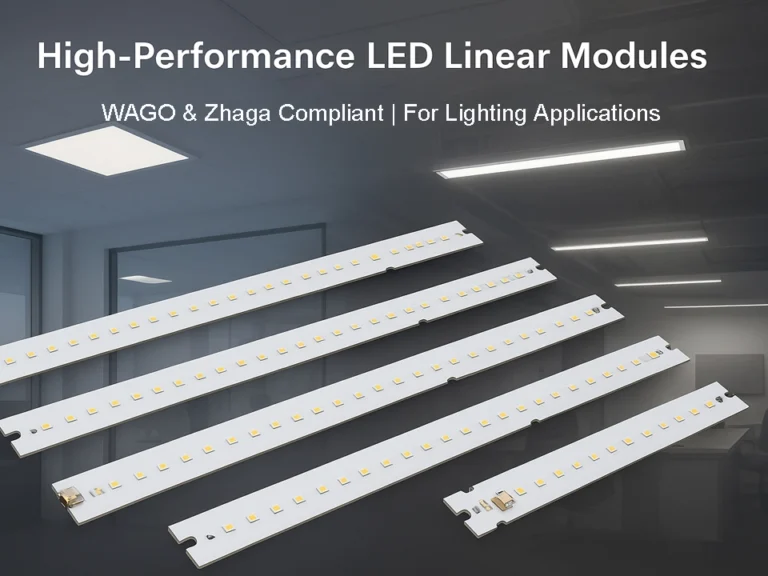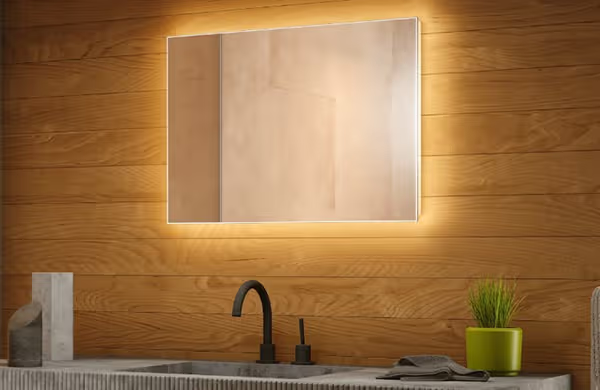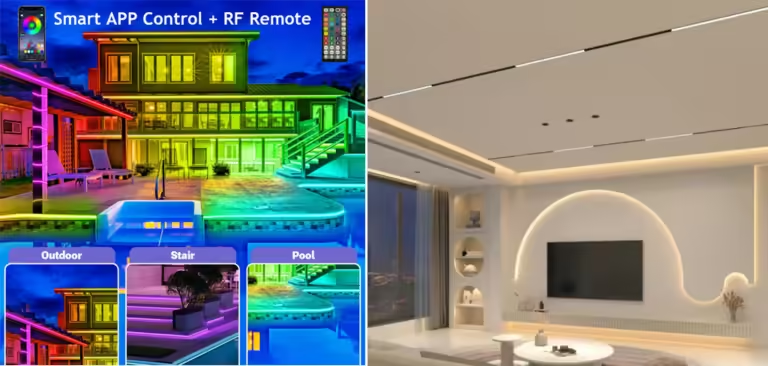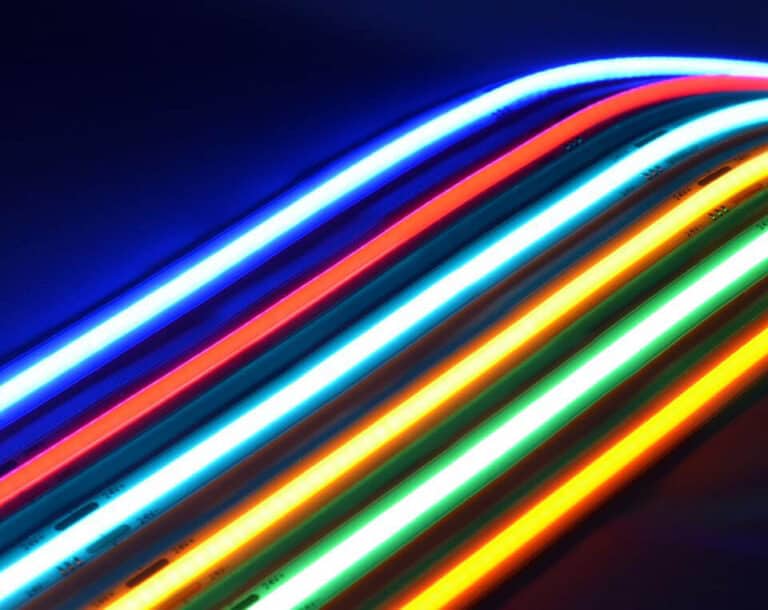Inleiding: de rol van verlichting in kantoorproductiviteit
De verschuiving naar hybride werk na de pandemie heeft veel bedrijven ertoe aangezet om te heroverwegen hoe kantoorruimtes worden ontworpen. Om werknemers aan te moedigen om terug te keren, geven bedrijven prioriteit aan gezondere, comfortabelere omgevingen - gericht op luchtkwaliteit, akoestiek en verlichting.
Vooral verlichting heeft een direct effect op het comfort, de concentratie en het welzijn van werknemers. Een studie van de American Society of Interior Designers, in samenwerking met Cornell University en Delos, onthulde dat 68% van kantoormedewerkers ontevreden was over hun verlichting. Deze ontevredenheid houdt vaak verband met door verblinding veroorzaakte oogbelasting, vaste kleurtemperaturen die niet voldoen aan de taakvereisten, of te harde verlichting in ruimtes die bedoeld zijn voor ontspanning.
Tunable witte LED lineaire verlichting Bied een praktische oplossing.
Door dynamische aanpassing van de kleurtemperatuur mogelijk te maken - van warme 2700K tot koele 6500K - ondersteunen deze armaturen het natuurlijke circadiane ritme van het lichaam, verminderen ze het ongemak veroorzaakt door slechte verlichting en creëren ze omgevingen die beter geschikt zijn voor de gevarieerde activiteiten binnen een modern kantoor.
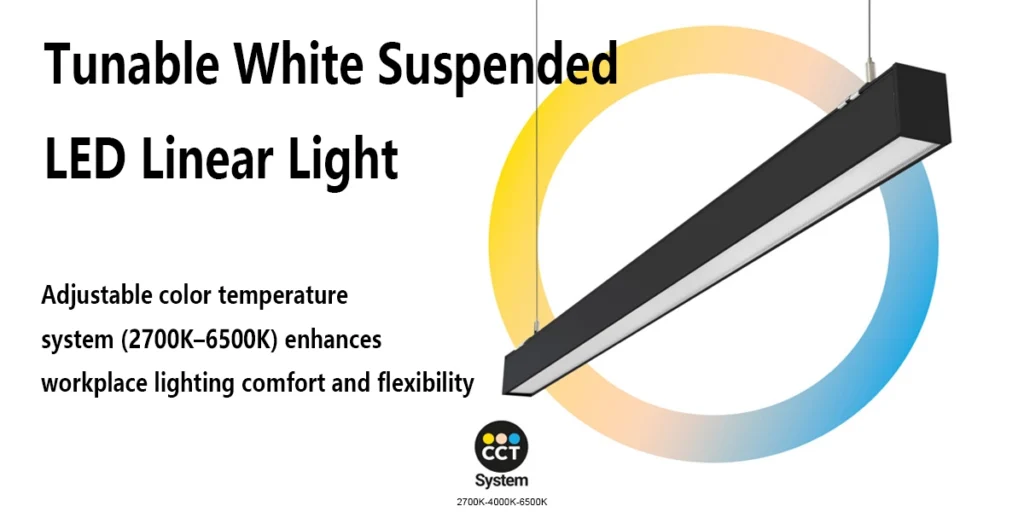
Wat zijn afstembare witte LED-lineaire verlichting?
Tunable witte LED lineaire lichten zijn Lange lineaire LED-verlichtingsarmaturen waarmee gebruikers de kleurtemperatuur van de verlichting gedurende de dag kunnen aanpassen, meestal van Warm 2700K om 6500K af te koelen.
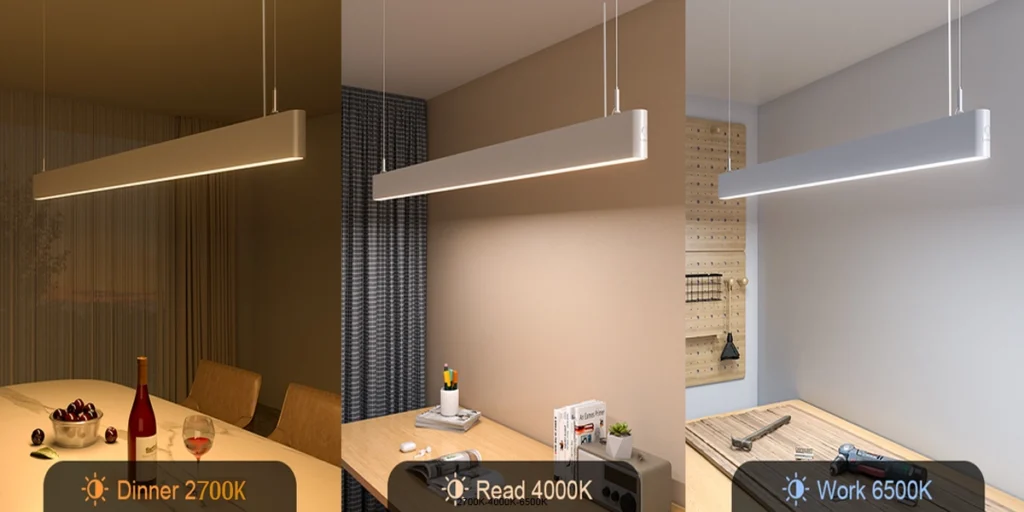
Warme tonen (ongeveer 2700K-3000K) creëren een rustige en gastvrije sfeer, ideaal voor lounges of informele ontmoetingsruimtes. Koelere tonen (5000K-6500K) bevorderen alertheid en focus, waardoor ze geschikt zijn voor taakverlichting in werkstations, vergaderruimtes of samenwerkingsruimten.
In termen van vorm worden deze armaturen bepaald door hun slanke, langwerpige lineaire vorm. Gemeenschappelijke lengtes zijn onder meer 1,2 meter en 2,4 meter, met de flexibiliteit om als standalone eenheden te gebruiken of meerdere armaturen in volgorde of matrixlay-outs te koppelen.
De brede straalhoek - meestal tussen 120° en 160° - zorgt voor uniforme, schaduwvrije verlichting over grote gebieden. Dit maakt ze vooral geschikt voor open kantoren, gangen of creatieve studio's waar zowel functionele verlichting als visuele esthetiek vereist zijn.
Deze lampen gebruiken vaak een dual-chip setup, waarbij warmwitte en koele witte LED's op een enkel bord worden gecombineerd. Besturingsopties zijn onder meer DALI, 0-10V dimmen, DMX en app-gebaseerde slimme systemen voor realtime of geplande aanpassingen.
Toepassingsscenario's: het verbeteren van verschillende kantoorzones
Tunable White LED Linear Lights zijn ideaal voor moderne kantooromgevingen die flexibiliteit, comfort en energie-efficiëntie vereisen. Door de kleurtemperatuur en helderheid aan te passen op basis van de activiteit en het tijdstip van de dag, ondersteunen deze armaturen zowel de visuele prestaties als het welzijn van de inzittenden.
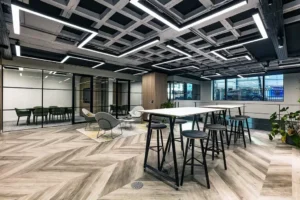
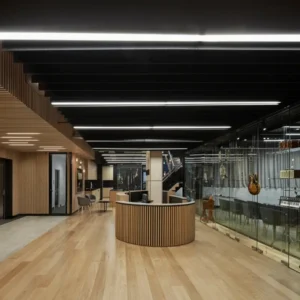
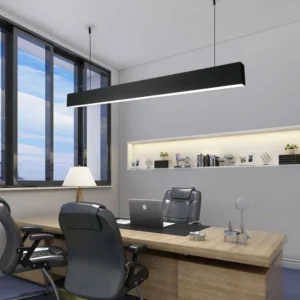
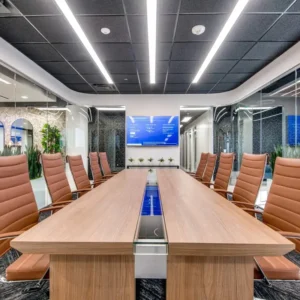
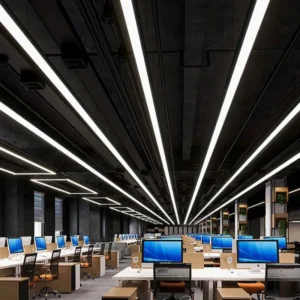
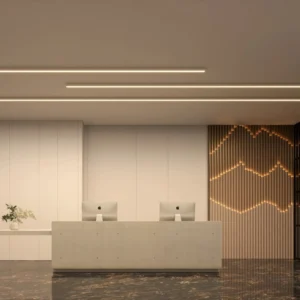
Open werkruimten
Koelere tonen (5000K-6500K) worden aanbevolen om de focus en productiviteit te verbeteren. Voor optimaal visueel comfort is het raadzaam om de armaturen te combineren met low-glare diffusers (UGR 19) om schermreflecties te minimaliseren.
De installatiehoogte moet doorgaans variëren van 2,5 tot 3 meter boven het bureauniveau om een gelijkmatige lichtverdeling over werkstations te garanderen.
vergaderzalen
Tunable Lighting ondersteunt voorgeprogrammeerde scènes die zijn afgestemd op verschillende soorten vergaderingen:
- Videoconferentiemodus: 4000K, 400 lux, met focusverlichting op de gezichten van de deelnemers om de duidelijkheid op de camera te vergroten.
- Brainstormmodus: 3500K, 300 lux, met licht gedimd (-10%) op de omtrek van de kamer om een ontspannen, gerichte sfeer te creëren.
Dimmen en kleurveranderingen kunnen worden geregeld via wandpanelen, DALI-systemen of app-gebaseerde platforms, waardoor naadloze overgangen tussen modi mogelijk zijn.
Receptiegebieden
De receptie zet de toon voor zowel bezoekers als personeel. Een neutrale tot licht warme witte tint (3000K-4000K) helpt een gastvrije sfeer te creëren zonder overdreven casual te lijken.
Lineaire armaturen kunnen worden opgeschort om een architectonisch ritme aan de ruimte toe te voegen. In sommige ontwerpen zijn ze gerangschikt in parallelle of geometrische patronen om de visuele interesse te vergroten.
Breakout-zones en lounges
In breakout-gebieden waar werknemers korte pauzes nemen, hebben zachtere warme tonen (2700K-3000K) de voorkeur om ontspanning en mentaal herstel te bevorderen.
Lagere belichtingsniveaus (150-250 lux) in combinatie met indirecte verlichting of diffuse armaturen kunnen de stimulatie en visuele spanning helpen verminderen.
Multifunctionele kamers en trainingsruimtes
Deze ruimtes vereisen flexibiliteit. Tunable White LED Linear Lights maken verlichting mogelijk om zich aan te passen aan verschillende activiteiten: training, presentaties of informele discussies.
Typische opstellingen kunnen zijn:
- Presentatiemodus: 5000K, 500 Lux
- Trainingsmodus: 4000K, 350–400 Lux
- Discussiemodus: 3500K, 300 lux
Slimme besturingssystemen kunnen snelle scènes schakelen mogelijk maken om te passen bij verschillende functies van de kamer.
Zie voor meer lichtvormen en hun architecturale toepassingen Led lineaire verlichtingstypes en -toepassingen voor moderne architectuurprojecten.
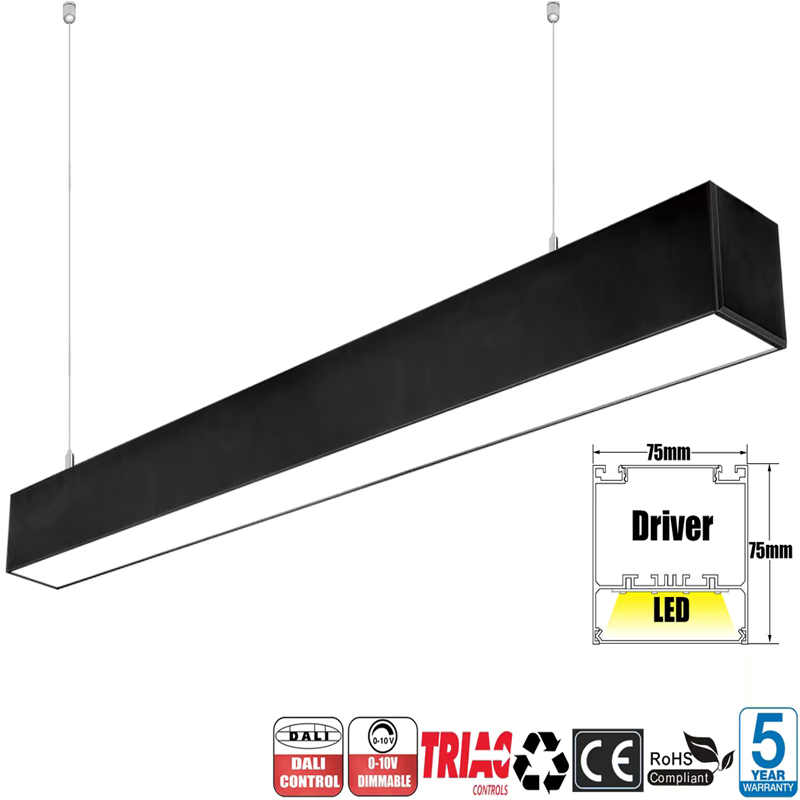
W75*H75mm profiel LED lineair licht
Ingangsspanning: AC100-277V/AC220-240V, 50-60Hz
materiaal: 6063 Aluminiumprofiel + opaal diffuser / microprisma diffuser
LED-chip: SMD2835
Kleur temperatuur: 3000K/4000K/6000K/2700-6500K
Lichtstroom: 100-110lm/w@>80Ra
UGR: <19
flikker vrij: Ja
Functie-optie: Aan/Uit Geen dimmen/0-10V/Triac/Dali/Dali DT8
Kleuroptie afwerken: Zwart/Wit/Zilver
Profielgrootte optie: W75*H75mm
Lengte optie: 600mm/1200mm/1800mm/aangepast beschikbaar
IP-cijfer: IP20
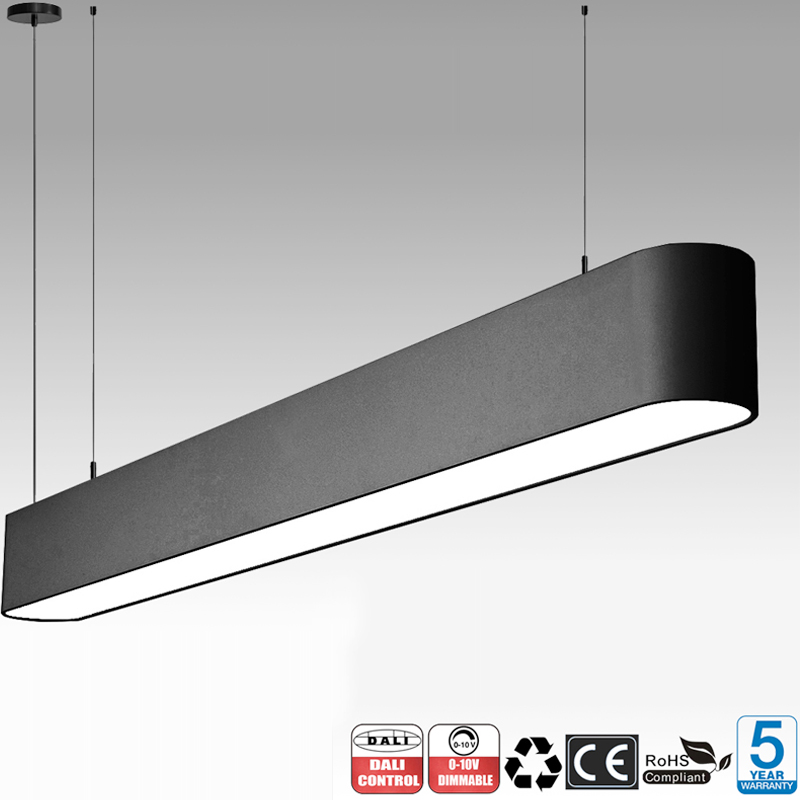
W60xH80mm Rond Hoekprofiel LED Lineair Licht
Ingangsspanning: AC100-277V/AC220-240V, 50/60Hz
Profielgrootte: W60*H80mm
Lengte: 600mm/1200mm/1500mm/1800mm/2400mm
Lichtstroom: 100-110lm/w@80ra
Watt: 20W/40W/60W/80W
Kleurtemperatuur: 3000K/4000K/6000K/2700-6500K
Stralingshoek: 120°
LED-chip: SMD2835
Materiaal: 6063 Aluminiumprofiel + opaal diffuser
Kleuroptie afwerken: Zwart/Wit/Zilver
Functie-optie: Niet-dimmen/0-10V dimmen/Dali dimmen
Installatieoptie: Ophanging/plafondbevestiging
IP-klasse: IP20
Voordelen van afstembare witte LED-lineaire verlichting in kantoren
Tunable White LED Linear Lights bieden meer dan alleen visueel comfort - ze creëren adaptieve, mensgerichte werkruimten die welzijn, productiviteit en efficiëntie op lange termijn bevorderen. Belangrijke voordelen zijn onder meer:
Ondersteunt het welzijn en de productiviteit van werknemers
Door de kleurtemperatuur aan te passen in afstemming met natuurlijke circadiane ritmes, helpt Tunable White Lighting werknemers om gedurende de dag alert te blijven en vermindert vermoeidheid, vermoeide ogen en slaapverstoring.
Een studie uit 2013 van het Lighting Research Center (LRC) van het Rensselaer Polytechnic Institute wees uit dat kantoormedewerkers die werden blootgesteld aan op de mens gerichte tunable verlichting, een betere slaapkwaliteit en lagere niveaus van stress en depressie rapporteerden in vergelijking met die onder conventionele verlichting.
In een andere real-world applicatie werkte CBRE Nederland samen met twee universiteiten om tijdgestuurde Tunable Lighting in hun kantoor in Amsterdam te installeren. In een periode van 7 maanden hebben 120 medewerkers ervaren:
- 18% verhoging van de productiviteit
- 12% verbetering van de werknauwkeurigheid
- 76% boost in gerapporteerd geluk
- 71% van medewerkers voelde zich meer energiek
- 50% meldde zich gezonder te voelen
Toen de studie eindigde en het kantoor terugkeerde naar de oorspronkelijke verlichting, was een van de meest voorkomende verzoeken van het personeel om het afstembare verlichtingssysteem te herstellen - wat de positieve psychologische en fysiologische effecten ervan benadrukte. Deze bevindingen versterken de waarde van Tunable White Lighting bij het bevorderen van gezondere, meer betrokken en productievere kantooromgevingen.
Flexibele en esthetische ontwerpopties
Slim lineaire armaturen zijn zeer veelzijdig voor moderne architecturale integratie.
Hangende ontwerpen - vaak bekend als afstembare witte LED-hanglampen of hangende lineaire lichten voor kantoren - helpen bij het creëren van visuele interesse in open ruimtes
Inbouwopties of opbouwopties passen bij minimalistische, ruimtebesparende interieurs
Lichtontwerpers kunnen op maat gemaakte omgevingen creëren die zowel de functie als de esthetiek verbeteren.
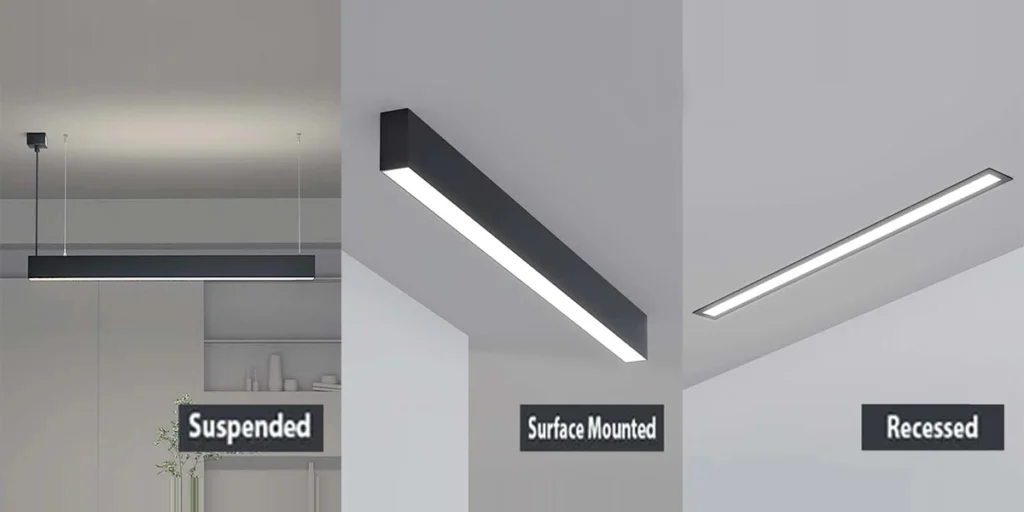
Verbeterde controle en energie-efficiëntie
Tunable White LED Linear Lights zijn inherent energiezuinig, verbruiken doorgaans 40%-60% minder vermogen in vergelijking met traditionele fluorescerende armaturen zoals T5 of T8-buizen.
In open kantoren of gedeelde werkruimten kan één afstembare armatuur twee functies bieden, zowel taakverlichting als omgevingsverlichting, waardoor het aantal benodigde armaturen wordt verminderd.
Wanneer geïntegreerd met slimme lichtregelingen, zoals bezettingssensoren, daglichtoogsten of tijdgebonden dimmen, kan het energieverbruik nog verder worden verminderd.
In vergaderruimtes of gangen kan verlichting bijvoorbeeld automatisch dimmen tot 20% standby-helderheid wanneer deze niet wordt bezet, waardoor een extra 30% of meer wordt bespaard tijdens de daluren.
Deze combinatie van basis-LED-efficiëntie en slimme controle verlaagt niet alleen de energierekening, maar verlengt ook de levensduur van de armatuur, vermindert de onderhoudsfrequentie en ondersteunt LEED- of putbouwcertificeringen.
Positieve impact op bedrijfsimago
Een goed verlicht kantoor brengt een toewijding aan welzijn, duurzaamheid en modern design. Zowel klanten als medewerkers voelen zich aangetrokken tot heldere, adaptieve en visueel aantrekkelijke ruimtes - waardoor uw merkervaring wordt verbeterd vanaf het moment dat ze binnenkomen.
Belangrijkste overwegingen voor selectie en installatie
Het kiezen van de juiste afstembare witte LED-lineaire verlichting zorgt ervoor dat uw kantoorverlichting betrouwbaar presteert en de werkruimte verbetert. Dit zijn de belangrijkste factoren waarmee u rekening moet houden:
Kleurenbereik en lichtkwaliteit
Selecteer armaturen die een Volledig spectrum van warm tot koel wit licht (ongeveer 2700K-6500K).
Warmere tonen creëren een ontspannen sfeer voor lounges of informele ruimtes.
Koelere tonen verbeteren de focus en zichtbaarheid in werkzones.
Hoge CRI (90+) verlichting wordt aanbevolen om ervoor te zorgen dat kleuren er natuurlijk uitzien en visuele vermoeidheid verminderen.
Armatuurtypes en montagemogelijkheden
Verschillende kantoorlay-outs vragen om verschillende installatiemethoden:
Inbouw: voor naadloze integratie in plafonds met een strakke, minimalistische uitstraling.
Opgeschort/hanger: ideaal voor open plafonds, met zowel verlichting als decoratieve waarde.
Opbouwmontage: Geschikt voor betonnen of zichtbare plafonds met beperkte installatiediepte.
Track-mounted (optioneel): flexibel voor herconfigureerbare ruimtes, zoals showrooms of collaboratieve hubs.
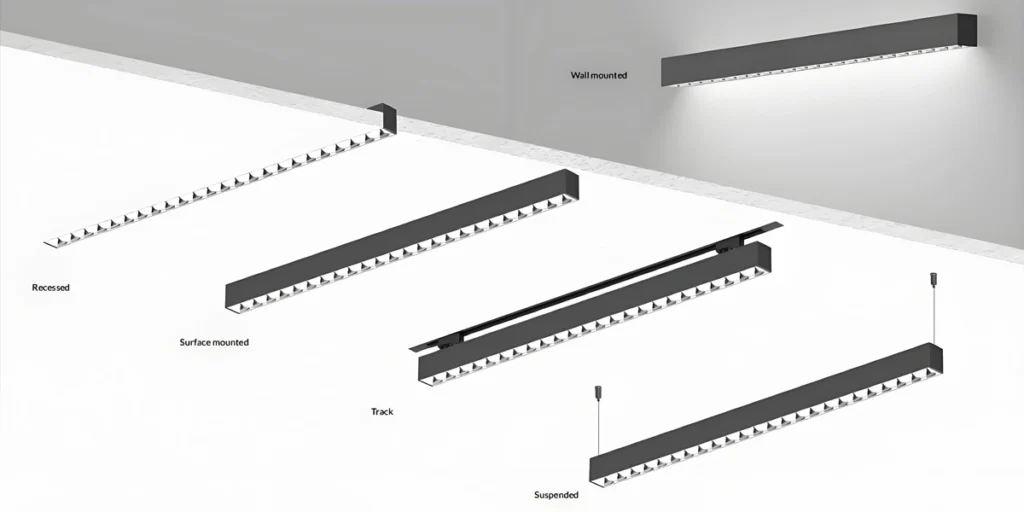
Controle en integratie
Tunable White LED Lineaire lichten kunnen worden bediend via verschillende protocollen, zoals lakei, 0–10V, DMX of draadloze app-gebaseerde systemen. Hierdoor kunnen facility managers dynamische lichtscènes implementeren die aansluiten bij het tijdstip van de dag of specifieke werkplekfuncties.
In slimme kantooromgevingen maakt het integreren van verlichting met gebouwbeheersystemen geautomatiseerde planning, op bezetting gebaseerde aanpassingen en realtime afstandsbediening mogelijk.
Overweeg voor grote kantoren of commerciële ruimtes een kleinschalige pilot (bijv. 1-2 werkstations of een vergaderruimte) om de prestaties te verifiëren voordat u volledig wordt geïnstalleerd.
Energie-efficiëntie en levensduur
Kies armaturen met een hoge lichtopbrengst om het energieverbruik te verminderen.
Zoek naar meer dan 50.000 uur levensduur, waardoor de betrouwbaarheid op lange termijn wordt gegarandeerd met minimaal onderhoud.
Installatie en onderhoud
Overweeg het type plafond en de bedradingslay-out vroeg in het ontwerpproces. Modulaire lineaire systemen zijn eenvoudiger te installeren, te onderhouden en uit te breiden als uw kantoorlay-out in de toekomst verandert.
Conclusie
Tunable White LED lineaire lampen bieden een praktische manier om moderne kantoren om te vormen tot gezondere, aantrekkelijkere en productiviteitsgerichte omgevingen. Door de kleurtemperatuur gedurende de dag aan te passen, ondersteunen ze het circadiane ritme, verminderen ze de vermoeidheid van de ogen en verbeteren ze het algehele comfort van de werknemers.
Met veelzijdige opties zoals hangende/ophangende LED-lineaire verlichting, verzonken armaturen en ontwerpen op het oppervlak, passen deze oplossingen zich aan aan elke kantoorindeling, of het nu gaat om een open werkruimte, privékantoor, vergaderruimte of receptie. In combinatie met slimme bedieningselementen leveren ze zowel energie-efficiëntie als mensgerichte prestaties.
Wilt u uw werkruimte upgraden met Tunable White LED Linear Lighting? Het SignLiteled-team kan u helpen bij het selecteren van geschikte armaturen, het ontwerpen van energiezuinige lay-outs en het bieden van betrouwbare OEM/ODM-ondersteuning die is afgestemd op uw projectbehoeften. Neem contact met ons op om te ontdekken hoe mensgerichte verlichting uw kantooromgeving kan verbeteren.
